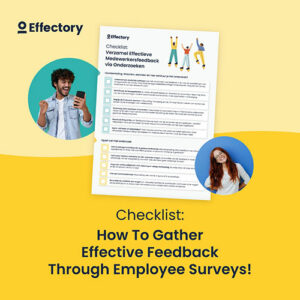You want to get started gathering feedback from your employees. Thankfully, you don’t have to look very far to find the best ideas for improving your organisation. You can simply go to your own team or organisation. Your employees are full of ideas about what is going well and where there is room for improvement. Who better than your own employees, know what can be done smarter, be more customer orientated, and fun? Their feedback helps your organisation be successful and flexible in the long run, in a world where technological and social developments are constantly changing.
5 Tips to consider before gathering employee feedback

Successful gathering feedback is almost entirely based on good preparation. First, it’s important to determine what the purpose or topics you want to gather feedback about, by defining the scope of the project. Following this, the practical implementation begins. Which method is appropriate for your organisation or team? What is the best timing to conduct a survey? And will collection be based of central or decentralized feedback? We are happy to help you make the right choices to form the basis of successfully gathering employee feedback.
1. When do you want to collect feedback?
The employee journey is the time spent that anyone employed by your organisation takes. It’s when an employee joins, grows and develops, works in teams, and eventually departs the organisation. It’s during this process that feedback should be requested, either based on different moments and topics. Feedback can be gathered, for example when a new employee has joined the organisation and is completing the onboarding process, or when working in teams, or on specific themes that are apparent within the organisation. First off, you’ll want to determine the moments during the employee journey that you want to collect your feedback. You’ll also want to determine exactly what it is that you want to know about your employees.
2. Which method will you use?
Which method suites your organisation or team? This is an important point in the preparation phases. You’ll need to know whether this is an undertaking you and your team can take on, or if it is something that should be outsourced to a specialist or agency. There are several methods which can be considered for collecting employee feedback. In general, these include:
- Quantitative feedback: a survey (digital or print)
- Qualitative feedback: for example, in-depth interviews or panel discussions
- A combination of both quantitative and qualitative feedback
3. How frequently is it necessary to collect feedback?
Organisations experience change more and more often these days. It’s a necessity, and can be due to a variety of factors like political policy, technology and market developments. How often do you need to gather feedback from your employees, to keep up with this rate of change? Organisation-wide surveys are often conducted on an annual or biennial basis. This is one way to get employee feedback, but if you’re working in a fast-paced environment, this frequency may be too low. More and more organisations desire the flexibility of a pulse survey, because they can quickly and more regularly collect feedback on specific topics, or specific samples. Thus, allowing them the flexibility they need to react and anticipate change.
How to gather feedback from your employees
The definitive checklist for creating your employee engagement survey.
Download4. Do you want centralised or decentralised feedback?
Employee feedback can be obtained at multiple different levels. For instance, as a centralised fixed template with a defined feedback moment, or decentralised allowing teams or departments the freedom to collect feedback, when and how they prefer. Before choosing for one way or the other, it’s important to consider which employee samples will be asked on which topics. Relevance is important here. Maintain focus on keeping the quality of feedback as high as possible, and on increasing the response rate.
5. Which questions will you ask?
The formulation of questions determines the type and content of feedback you’ll receive. Try to create questions in such a way, that they do not elicit socially acceptable answers. Many professional agencies have their own set of questionnaires that can be customised or adjusted to suite your specific needs.
Ensure Success
Ensure that you have a successful start for gathering employee feedback by carefully considering the topics above! We have more practical tips and tricks for you to consider when gathering employee feedback. For example, a closer consider the methods of collecting feedback, how to handle internal communication, or how to gather and analyse results of the feedback into clear actionable items. Download our free checklist: Successfully gather feedback from your employees, to learn more!
Need more help?
Make sure you consider the above tips before starting your survey. If you’re looking for more help, check out our free survey checklist – or drop us a line. We’re happy to help!
About Effectory
Based in Amsterdam, Effectory is Europe’s largest independent employee survey provider, with over 20 years of experience in helping organisations become sustainably successful. We believe the key to sustainable success, is through gathering and listening to employee feedback. To facilitate this, we offer a variety of feedback tools which enable companies to learn from their employees and improve from within. In 2016, Effectory conducted over 600 employee surveys globally, with +1.5 million respondents in over 40 languages. Effectory is mission-driven, and we pride ourselves in having engaged, passionate employees with a very open, honest and trusting working culture.
